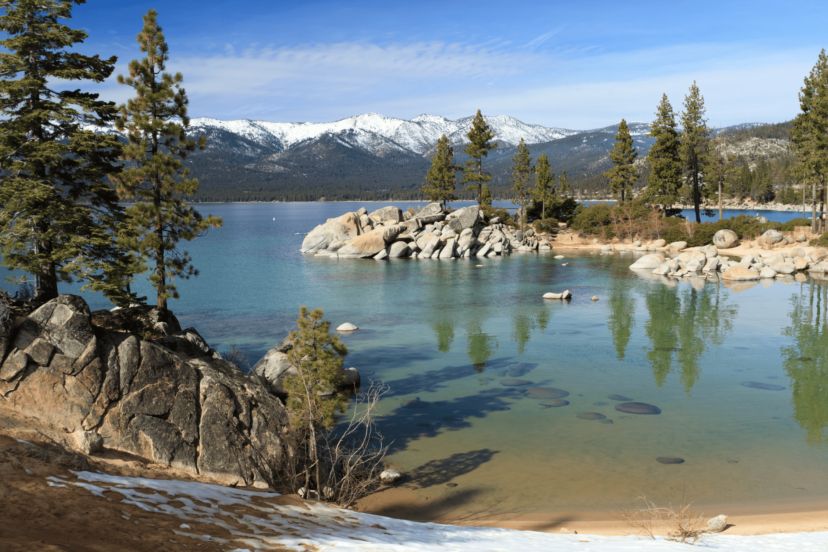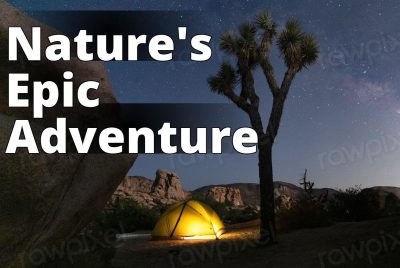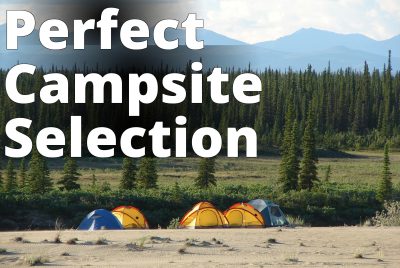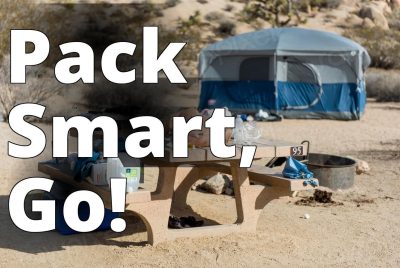Lake Tahoe Camping: Your Ultimate Guide
Looking for a family-friendly adventure that combines stunning natural beauty with thrilling outdoor activities?
Look no further than Lake Tahoe camping! Nestled in the heart of the Sierra Nevada Mountains, Lake Tahoe is a breathtakingly beautiful freshwater lake that straddles the California-Nevada border.
With its crystal-clear waters, towering pine trees, and majestic mountain peaks, this iconic destination has been attracting visitors for generations.
Whether you’re looking for family campsites or want to explore the rugged terrain of Desolation Wilderness on National Forest land, Lake Tahoe camping offers endless opportunities for adventure.
Don’t miss out on Kaspian Campground, a popular spot for families and outdoor enthusiasts alike!
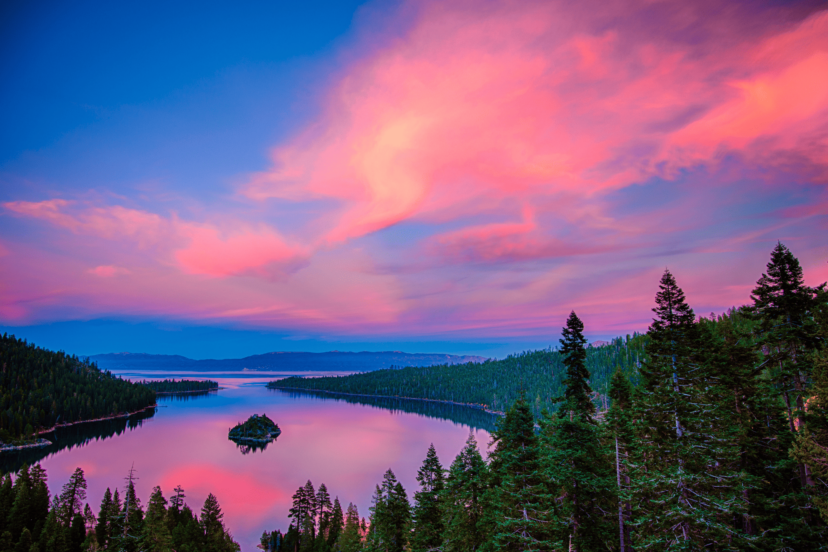
But it’s not just the scenery that draws people to Lake Tahoe camping. From tent camping to family campsites with picnic areas, to RV sites with full hookups, there are plenty of options for every type of camper.
And with campgrounds like Eagle Point and Nevada Beach offering lake frontage and easy access to hiking trails and water sports, outdoor activities are abundant for those who seek adventure in nature.
Of course, with such a pristine natural environment comes a responsibility to preserve it. That’s why it’s crucial for all campers in the Lake Tahoe Basin – whether at popular spots like South Lake Tahoe or lesser-known gems like Lake Forest Campground – to be mindful of their impact on the ecosystem.
By following Leave No Trace principles and working with campground hosts and park rangers at places like Tahoe SRA and Tahoe City, we can all do our part to ensure that future generations can enjoy this incredible destination as much as we do.
For families looking for camping options, there are many family campsites available in the area. Tent camping is also popular, and most campsites have designated campfire rings for a cozy evening under the stars.
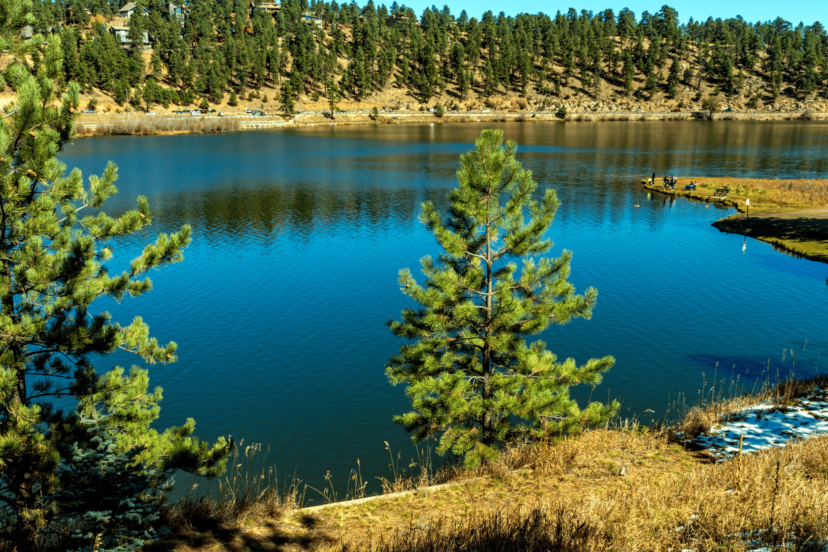
Top Lake Tahoe Campgrounds by the Water in Any Season
Advantages and disadvantages of camping near the water
Camping near the water can be a great experience for families who love nature.
The sound of waves hitting the shore, the cool breeze, and stunning views make it a perfect spot for family campsites.
However, there are also some disadvantages to consider before choosing a campsite near the water. It’s important to check campground amenities and outdoor activities available nearby, as well as whether there is a campground host on site.
Advantages:
-
Beautiful scenery
-
Soothing sounds
-
Cool breeze
-
Access to water activities like swimming and fishing
Disadvantages:
-
Bugs and insects
-
Risk of flooding or high tides
-
Humidity and dampness in tents or gear
-
Difficulty finding level ground for tents
Top-rated campgrounds in Lake Tahoe area
Lake Tahoe offers several camping options, including top-rated family campsites for tent camping. These sites provide stunning views, beautiful trails, and access to various recreational activities. Don’t forget to bring your tents for a memorable camping experience in Lake Tahoe.
Emerald Bay State Park – This campground offers campsites and tents at the south end of Lake Tahoe, with access to hiking trails and outdoor activities around Emerald Bay. There is also a picnic area available for visitors.
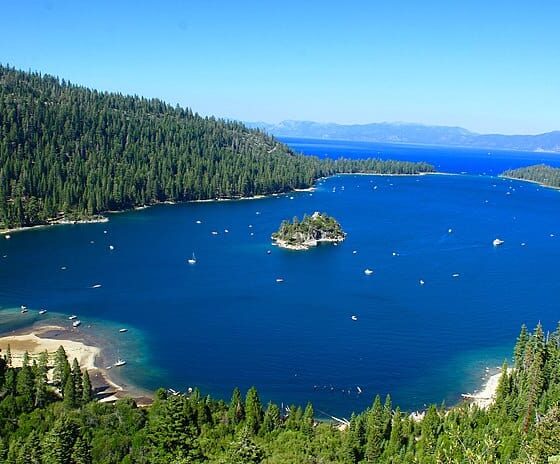
Fallen Leaf Campground – Located on Highway 89, this campground offers easy access to campsites, beaches, and trails around Fallen Leaf Lake. There is also a picnic area available for use. Those looking to pitch tents can do so here as well. The campground is conveniently located near Tahoe City.
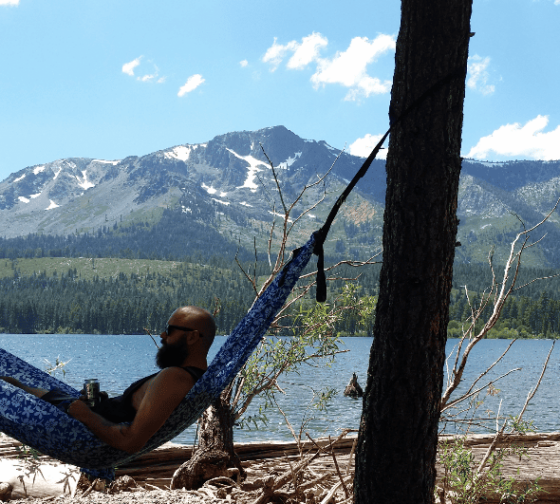
Meeks Bay Resort & Marina – This lakefront resort offers campground amenities, including campsites right on the beach with access to boating activities. There is also a picnic area available for guests to enjoy the stunning Lake Tahoe frontage. Check out one of the best Lake Tahoe campgrounds for an unforgettable experience.
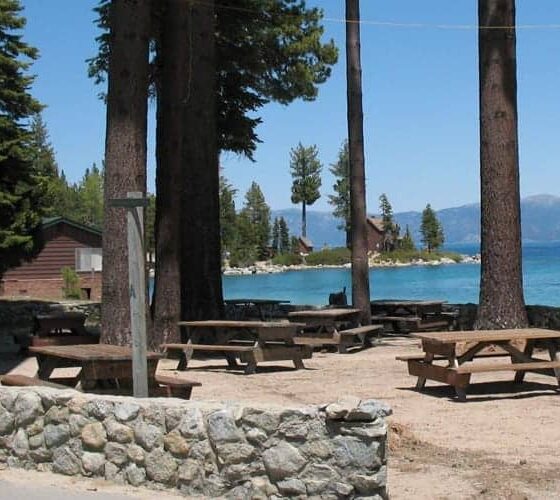
D.L Bliss State Park – Located on Highway 89 near Emerald Bay, this park offers beautiful views of Rubicon Point Lighthouse. Visitors can also enjoy campsites and a picnic area nearby, as well as exploring the stunning scenery of Fallen Leaf Lake and South Lake Tahoe.
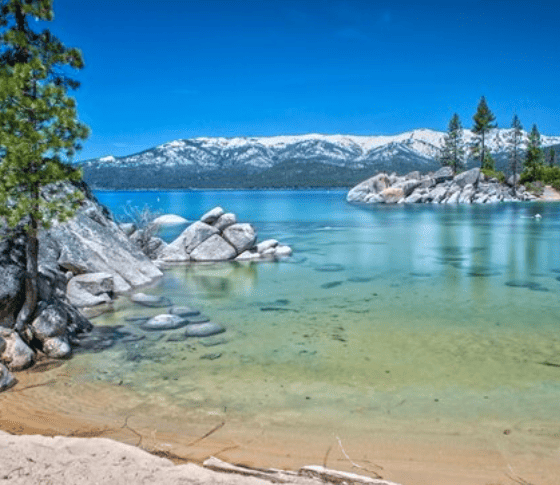
Zephyr Cove Resort – This resort offers cabins and campsites right on the beach with access to boat rentals. Additionally, it provides campground amenities for those who prefer to stay in tents, making it one of the best Lake Tahoe campgrounds. Located in South Lake Tahoe, it’s the perfect spot for a camping adventure.

Factors to consider when choosing a campground in Lake Tahoe
When choosing a campground or campsites in Lake Tahoe area for your tents, there are several factors you should consider such as location, amenities, cost, accessibility, parking, drinking water, weather conditions among others.
-
Location: Consider whether you want to be close to the lake or in a more secluded area with suitable campsites, parking, and campground amenities. Don’t forget to check if there’s a friendly camp host available to assist you during your stay.
-
Amenities: Check for campsites, parking, showers, toilets, fire pits, picnic tables, drinking water and fallen leaf lake.
-
Cost: Determine your budget and compare prices of different campsites and parking options for mid-range stays with drinking water.
-
Accessibility: Consider how easy it is to get to the campsites and whether they’re suitable for your vehicle. Check for drinking water availability and mid location of flush toilets.
-
Weather conditions: Check weather forecasts before choosing a campground or campsites as some areas may experience extreme weather conditions during certain seasons. Also, ensure the availability of drinking water and flush toilets, especially during mid-season.
Ideal time for camping in different seasons
Lake Tahoe is an all-year-round destination with each season offering unique experiences. However, the ideal time for camping depends on personal preferences and activities you plan to do while there. There are many campsites available in the area, so finding a suitable one should not be a problem. Additionally, make sure to check if the campsites have access to drinking water before booking.
-
Summer (June-August): This is peak season with warm temperatures perfect for water activities like swimming, boating, and fishing. If you’re looking for campsites, consider visiting Camp Richardson.
-
Fall (September-November): The crowds are smaller during this season with cooler temperatures and stunning fall foliage views. There are plenty of campsites available and drinking water is easily accessible.
-
Winter (December-February): With snowfall comes skiing and snowboarding opportunities in nearby ski resorts. Some campsites offer access to drinking water for those looking to explore the winter wonderland.
Top Recommended Campgrounds: Fallen Leaf, Meeks Bay, and William Kent:
Are you planning a camping trip to Lake Tahoe? With so many campgrounds and campsites to choose from, it can be overwhelming trying to decide where to stay. That’s why we’ve narrowed down the top three recommended campsites for your next adventure: Fallen Leaf, Meeks Bay, and William Kent.
Location and Facilities Available at Each Campground
Fallen Leaf Campground is located on the south shore of Lake Tahoe near Fallen Leaf Lake. It has 205 campsites with flush toilets and showers available. The campground also offers picnic tables, fire pits, and food storage lockers. There are hiking trails nearby that lead to waterfalls and scenic views.
Meeks Bay Campground offers 40 campsites for tents with picnic tables and fire rings available. The campground also provides restrooms, showers, and food storage lockers. Nearby, there are beaches suitable for swimming and kayaking.
William Kent Campground is located on the north shore of Lake Tahoe near Tahoe City. It has 84 campsites with flush toilets available. The campground also offers picnic tables, fire pits, food storage lockers, and access to a bike trail that leads into town.
Activities Available Nearby Each Campground
Fallen Leaf Campground offers campsites within walking distance of Fallen Leaf Lake where visitors can fish or rent boats for water activities such as kayaking or paddleboarding. Hiking trails nearby include Angora Lakes Trailhead which leads to two beautiful alpine lakes surrounded by granite cliffs.
Meeks Bay Campground offers campsites right on the beach where visitors can swim in the lake or rent paddleboards and kayaks for water activities. There are also hiking trails nearby such as Eagle Falls Trailhead which leads hikers through a dense forest up to stunning views of Emerald Bay.
William Kent Campground offers spacious campsites a short walk from the Truckee River where visitors can fish for trout or go for a swim. There are also bike trails nearby such as the Tahoe City Lakeside Trail which offers scenic views of the lake and leads into town.
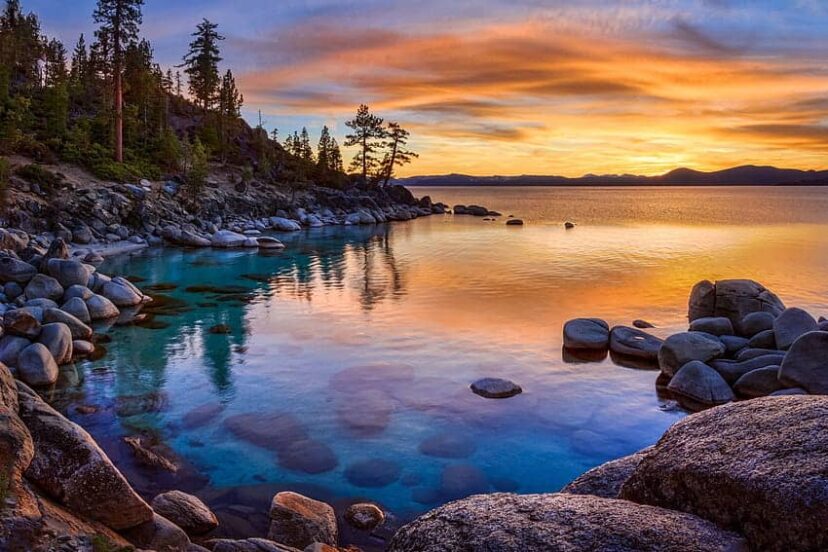
Reviews from Previous Campers About Their Experiences
Fallen Leaf Campground has received high ratings from previous campers who have praised its beautiful location, clean facilities, and friendly staff. Many have also noted that it can get crowded during peak season, but there are plenty of campsites available for those who plan ahead.
Meeks Bay Campground has been reviewed as a peaceful and quiet campground with stunning lake views. However, some campers have noted that there are limited amenities available, but the campsites provide a perfect spot for a serene getaway.
William Kent Campground has been praised for its convenient location near town and the river, offering spacious campsites. However, some campers have noted that it can be noisy due to its proximity to Highway 89.
Comparison Between These Three Top Recommended Campgrounds
When comparing these three top recommended campgrounds, it’s important to consider what activities you plan on doing during your trip and what amenities you need. Fallen Leaf is great for those looking to hike and enjoy water activities while Meeks Bay is perfect for those wanting a peaceful beach experience. Additionally, all three campgrounds offer spacious campsites for your stay.
Other Great Options: Nevada Beach and Tahoe Valley:
Nevada Beach: A Hidden Gem
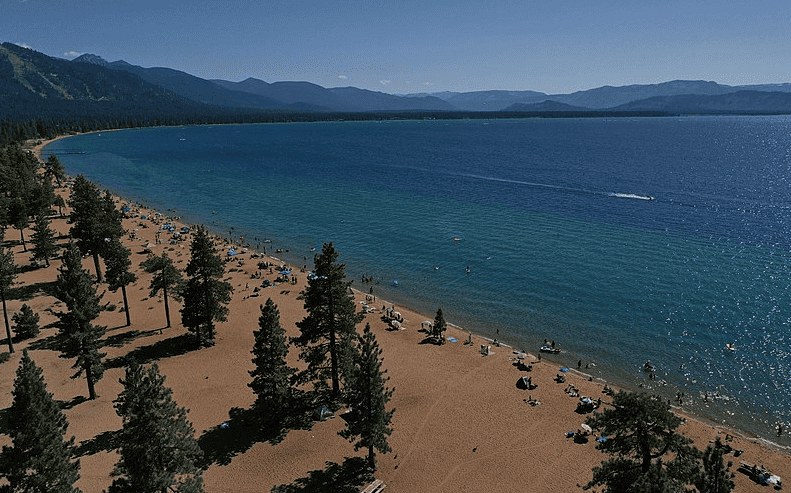
While many people flock to the popular Zephyr Cove Resort for their Lake Tahoe camping experience, few know about the hidden gem that is Nevada Beach. Located on the eastern shore of Lake Tahoe in Nevada, this beach offers an excellent location for campsites, those who want to escape the crowds of California.
One of the most significant features of Nevada Beach is its long stretch of sandy shoreline. Unlike some other beaches in the area, this one has plenty of space for visitors to spread out and enjoy themselves without feeling cramped or crowded. While there are no campsites available, there are several picnic areas available for use, making it a great spot for a family outing.
For those who love water sports and camping, Nevada Beach is an excellent choice. The clear waters of Lake Tahoe make it perfect for swimming, kayaking, paddleboarding, and more. There are also campsites available if you want to stay overnight and enjoy the beautiful surroundings. There’s even a boat launch if you want to bring your own watercraft.
If you’re looking for campsites that are a little more secluded than Zephyr Cove Resort but still want access to all the amenities you need, then Nevada Beach may be just what you’re looking for.
Tahoe Valley: A Campground with Something for Everyone
Tahoe Valley is another great option for campsites. This campground offers both RV and tent sites and has plenty of amenities to keep visitors entertained during their stay.
One thing that sets Tahoe Valley apart from other campgrounds and campsites in the area is its wide range of activities. From mini-golf and horseshoes to basketball and volleyball courts, there’s something here for everyone. There’s even a heated swimming pool if you want to take a dip without venturing into the lake itself.
Another great feature of Tahoe Valley is its proximity to campsites, restaurants, and shops.
Which One Should You Choose?
Both Nevada Beach and Tahoe Valley have their unique features that make them great options for Lake Tahoe camping campsites. Here’s a quick comparison to help you decide which one is right for you.
-
Nevada Beach: secluded location, sandy shoreline, water sports
-
Tahoe Valley: wide range of activities, heated swimming pool, proximity to restaurants and shops with campsites available.
If you’re looking for a more traditional camping experience with plenty of campsites and opportunities for outdoor recreation, then Nevada Beach may be the better choice. However, if you want access to all the amenities of home while still enjoying the great outdoors, then Tahoe Valley campsites is the way to go.
Regardless of which option you choose, one thing is certain: Lake Tahoe camping at campsites is an experience like no other. With its crystal-clear waters and stunning mountain views, there are plenty of campsites available for those who want to enjoy the great outdoors. It’s no wonder why so many people flock here every year. So pack up your tent or RV and get ready for an adventure you’ll never forget!
State Parks to Visit: Emerald Bay, Sugar Pine Point, and DL Bliss:
If you’re looking for an outdoor adventure that combines stunning natural beauty with camping, Lake Tahoe is the perfect destination. The crystal-clear waters of the lake are surrounded by towering mountains and dense pine forests, providing a picturesque setting for outdoor activities. One of the best ways to experience this natural wonder is by visiting one of the many state parks in the area that offer campsites. Here are three must-visit state parks around Lake Tahoe with campsites: Emerald Bay, Sugar Pine Point, and DL Bliss.
Overview of State Parks Located Around the Lake Area
Lake Tahoe is home to several state parks that offer unique experiences for visitors, including campsites. From hiking trails to water sports, each park has its own set of attractions and amenities that make it worth exploring. In addition to Emerald Bay, Sugar Pine Point, and DL Bliss, other popular state parks around Lake Tahoe with campsites include:
-
Donner Memorial State Park
-
Washoe Meadows State Park
-
Burton Creek State Park
-
Spooner Lake & Backcountry
Unique Features That Make Each Park Worth Visiting
Emerald Bay State Park is located on the southwest corner of Lake Tahoe and features a stunningly beautiful bay with an island in its center. Visitors can enjoy hiking trails that lead down to the shoreline or take a boat tour around the bay. While there are no campsites within the park, nearby campgrounds provide ample opportunities for camping enthusiasts. There’s also a historic mansion called Vikingsholm that’s open for tours during certain times of the year.
Sugar Pine Point State Park is situated on the west shore of Lake Tahoe and boasts over two miles of sandy beaches along with dense pine forest trails. The park also has a campground with 120 sites available for tent, RV camping, and campsites.
DL Bliss State Park, located on the south shore of Lake Tahoe, offers scenic views from its hiking trails overlooking Emerald Bay. The park also provides campsites for visitors to stay and enjoy the beauty of nature. Additionally, there is a beach area where visitors can swim or kayak in crystal-clear waters.
History Behind Each Park’s Establishment
Emerald Bay State Park, a National Natural Landmark established in 1953, offers beautiful campsites for visitors to enjoy. The park’s centerpiece is Fannette Island, the only island in Lake Tahoe, featuring a small stone building known as “Tea House” built in 1929.
Sugar Pine Point State Park offers campsites for visitors to enjoy. The park was originally owned by Isaias Hellman, a prominent banker from San Francisco who built a summer home on the property in the early 1900s. The estate was later sold to the state of California and turned into a state park.
DL Bliss State Park was named after Duane Leroy Bliss, who played an integral role in developing tourism around Lake Tahoe during the late 1800s. The park was established in 1929 and has since become one of the most popular destinations for outdoor enthusiasts visiting Lake Tahoe.
Tips for Making the Most Out of Your Visit
-
Use Google Maps address to navigate to each state park.
-
Bring plenty of water and snacks for hiking or camping trips.
-
Check weather conditions before going camping or hiking.
-
Rent bikes at Sugar Pine Point State Park to explore its scenic bike path.
Preserving Lake Tahoe’s Natural Resources While Camping:
Importance of preserving natural resources while camping at Lake Tahoe
Camping is a great way to connect with nature, but it’s important to remember that our actions can have an impact on the environment. When camping at Lake Tahoe, it’s crucial to be mindful of the natural resources around us and take steps to preserve them.
One of the most significant threats to the area is pollution, which can come from waste disposal, campfires, and even human waste. To help minimize your environmental impact while camping at Lake Tahoe, consider the following tips:
-
Use biodegradable soap when washing dishes or yourself in the lake
-
Bring reusable containers and utensils instead of disposable ones
-
Pack out all trash and recyclables
-
Avoid using campfire rings in non-designated areas
-
If allowed, use propane stoves for cooking instead of open fires
Ways to minimize environmental impact during your stay
In addition to being mindful of waste disposal and campfires, there are other ways to reduce your environmental impact while camping at Lake Tahoe.
Consider staying at one of the many campsites that offer full hookups for RVs or tents. This will allow you to conserve water and electricity by using onsite facilities rather than relying on your own resources.
Another option is to camp in Desolation Wilderness, where visitors are required to pack out all their waste and follow strict guidelines for protecting wildlife habitats.
Rules set by local authorities regarding waste disposal
Local authorities have established rules regarding waste disposal in order to protect Lake Tahoe’s natural resources. These rules include:
-
Packing out all trash and recyclables
-
Using designated restrooms or packing out human waste in bags specifically designed for this purpose
-
Only dumping gray water (from dishwashing or showering) into approved dump stations
It’s important to familiarize yourself with these rules before heading out on your trip so that you can do your part to protect the environment.
The role that visitors play in maintaining a healthy ecosystem
Visitors play a crucial role in maintaining a healthy ecosystem at Lake Tahoe. By following the rules set by local authorities and being mindful of our impact on the environment, we can help preserve this beautiful area for future generations to enjoy.
In addition to minimizing our environmental impact, there are other ways we can contribute to the health of the ecosystem. For example, consider participating in a volunteer program or donating to organizations that work to protect Lake Tahoe’s natural resources.
By taking these steps, we can all do our part in preserving Lake Tahoe’s natural beauty while still enjoying all that camping has to offer. So pack up your gear, hit the trails for some hiking and outdoor activities, and don’t forget to take care of this precious resource!
Tips for Responsible Camping in Lake Tahoe:
Safety First
Camping is an excellent way to enjoy nature and get away from the hustle and bustle of city life. However, it can also be dangerous if you are not prepared. Here are some safety tips for first-time campers:
-
Research the area before you go: Learn about the local weather conditions, wildlife, and any potential hazards.
-
Bring a first aid kit: Make sure your kit includes bandages, antiseptic wipes, pain relievers, and any prescription medications you need.
-
Pack appropriate clothing: Dress in layers so that you can adjust to changing temperatures. Bring waterproof gear and sturdy shoes.
-
Stay hydrated: Drink plenty of water throughout the day to prevent dehydration.
Precautions Before Heading Out
Before heading out into nature, there are some precautions you should take to ensure a safe camping trip:
-
Check fire restrictions: Wildfires are a real threat in California. Check with the local authorities for any fire restrictions or bans before lighting a fire.
-
Leave no trace: Respect the environment by packing out all your trash and leaving your campsite as clean as possible.
-
Secure your food: Store your food securely in bear-proof containers or hang it high up in trees to avoid attracting bears or other wildlife.
Essential Items You Should Pack
Packing for a camping trip can be overwhelming. Here are some essential items that every camper should bring:
-
Tent and sleeping bag: Choose a tent that fits your needs and make sure it’s easy to set up. Your sleeping bag should keep you warm on cold nights.
-
Cooking supplies: Bring a portable stove or grill, pots and pans, utensils, plates, cups, and a cooler.
-
Lighting equipment: Pack flashlights or lanterns with extra batteries or fuel. Consider bringing solar-powered lights as well.
-
Personal hygiene items: Toothbrushes, toothpaste, soap, shampoo, and toilet paper are essential items.
Guidelines for Responsible Behavior While Camping
Camping is a fun way to connect with nature. However, it’s important to be respectful of the environment and other campers. Here are some guidelines for responsible camping:
-
Follow the rules: Respect any posted signs and regulations in the area.
-
Keep noise levels down: Be considerate of other campers by keeping noise levels low.
-
Don’t disturb wildlife: Observe wildlife from a distance and avoid feeding or approaching them.
-
Use designated campsites: Avoid setting up camp in undesignated areas to prevent damage to the environment.
Conclusion and Final Thoughts:
Lake Tahoe camping offers a unique experience for nature lovers. The best campgrounds on the water are Fallen Leaf, Meeks Bay, and William Kent. Nevada Beach and Tahoe Valley are also great options to consider. If you’re interested in visiting state parks, Emerald Bay, Sugar Pine Point, and DL Bliss offer breathtaking views.
Preserving Lake Tahoe’s natural resources is crucial while camping. Follow these tips for responsible camping: use designated fire pits, pack out all trash, and avoid disturbing wildlife.
When planning your trip to Lake Tahoe for camping, keep in mind that the best time of year to visit is during the summer months when temperatures are mild.
Overall, Lake Tahoe camping provides an opportunity to disconnect from technology and immerse yourself in nature. So pack your bags, grab some friends or family members, and enjoy a peaceful getaway in one of America’s most beautiful destinations.
FAQs:
1. What should I bring with me when I go camping at Lake Tahoe?
It’s important to bring appropriate clothing for all weather conditions as well as sunscreen and insect repellent. Don’t forget to bring enough food and water for your entire stay as well as cooking supplies if needed.
2. Are there any restrictions on where I can camp at Lake Tahoe?
Yes, there are designated campsites within the area that require reservations ahead of time. It’s important to follow these guidelines to preserve the natural beauty of the area.
3. Can I have a campfire while camping at Lake Tahoe?
Yes, but only in designated fire pits within established campsites or picnic areas.
4. Is it safe to swim in Lake Tahoe while camping?
Yes! The water is generally safe for swimming during the summer months when temperatures are mild.
5. Are pets allowed at Lake Tahoe campgrounds?
Some campgrounds allow pets while others do not – it’s important to check ahead of time and follow all rules and regulations regarding pets while camping.
6. Can I fish in Lake Tahoe while camping?
Yes, fishing is allowed in the lake with a valid fishing license.
7. Is there electricity available at Lake Tahoe campgrounds?
Some campsites do offer electrical hookups, but it’s important to check ahead of time and plan accordingly if needed.

